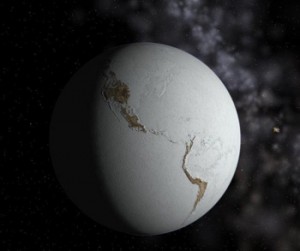 Much ado was made over the recent news that the Sun’s magnetic activity may be cooling off over the next few years. Can this mean the Earth itself will literally cool off, slipping into an ice age? Some news sites are reporting it that way (of course, the execrable Daily Mail uses the headline “Earth facing a mini-Ice Age ‘within ten years’ due to rare drop in sunspot activity”; which isn’t even within a glancing blow of reality).
Much ado was made over the recent news that the Sun’s magnetic activity may be cooling off over the next few years. Can this mean the Earth itself will literally cool off, slipping into an ice age? Some news sites are reporting it that way (of course, the execrable Daily Mail uses the headline “Earth facing a mini-Ice Age ‘within ten years’ due to rare drop in sunspot activity”; which isn’t even within a glancing blow of reality).
The answer – spoiler alert! – is almost certainly “no”. I want to make sure that’s clear, because I will bet essentially any amount of money that some climate change denial sites will run with this story and claim that we don’t need to worry about global warming. That’s baloney, and what follows is why. The reasons take a minute to explain, but of course that’s where the cool stuff (haha!) is. So let’s take this one step at a time. And if you have the attention span of an E. coli bacterium, you can skip down to the conclusion section.
[Note: a lot of this is taken from my book “Death from the Skies!”, where I interviewed approximately a bazillion people. One in particular was Caspar Ammann, who was very helpful in explaining the solar connection with the Little Ice Age to me.]
The Quiet Sun
The Sun has a magnetic cycle, its magnetic field waxing and waning in strength roughly every 11 years. The strength and complexity of the solar field governs a lot of the surface activity, including sunspots, solar flares, prominences, and coronal mass ejections.
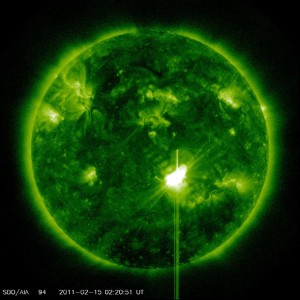 Right now, in 2011, we’ve just left a period of an extended minimum, and the next max is due in late 2013 and early 2014. But scientists studying the Sun have seen three independent lines of reasoning indicating that the next rise to the solar peak, in 2022 or so, may be delayed or even not occur at all. I wrote about this in an earlier post, so you can get the details there. It’s the core of the “oncoming ice age” claim, so you should read it.
Right now, in 2011, we’ve just left a period of an extended minimum, and the next max is due in late 2013 and early 2014. But scientists studying the Sun have seen three independent lines of reasoning indicating that the next rise to the solar peak, in 2022 or so, may be delayed or even not occur at all. I wrote about this in an earlier post, so you can get the details there. It’s the core of the “oncoming ice age” claim, so you should read it.
I’ll note right off the bat that not everyone agrees with these findings. Doug Biesecker, a solar physicist NOAA Space Weather Prediction Center [full disclosure: Doug is an acquaintance of mine; I interviewed him for an episode of “Bad Universe” about solar storms] , has written a document calling the findings into question. It’s not exactly a rebuttal; it’s more of a warning not to over-interpret the results. He also points out that a weak cycle may not have an effect on our climate; we simply don’t know for sure.
At this point you may be asking, so what? If the Sun has fewer sunspots and no flares, what difference does that make here on Earth? And how could it possibly trigger an ice age?
The Little Ice Age
In the late 17th and early 18th centuries, much of Europe experienced incredibly cold winters. People were ice skating on the Thames river (which was never before seen to have frozen, even in winter), glaciers in the Alps advanced, and the entire Dutch fleet of ships was frozen in its harbor. Oddly, summers were not much different, and much of the rest of the planet had normal winters (in North America winters were colder than normal, but not as bad as in Europe).
At the same time, the Sun was experiencing a 75-year long period later called The Maunder Minimum: few or no sunspots were to be found on the face of the Sun. That seems like a funny coincidence! And in fact, that’s the basis for this new claim that we might be entering an ice age: if no magnetic activity from the Sun once coincided with a cooling here on Earth, might it not do so again?
As we like to say in the skeptic’s business: correlation does not imply causation. In other words, beware of funny coincidences.
The Sun-Earth Connection
What we need to ask is, can the solar cycle cause an ice age? And even if it can, was the Little Ice Age sparked by the Maunder Minimum?
Given that essentially all the heat received by the Earth from space comes from the Sun, it seems like a no-brainer that the Sun affects our climate. But it’s not that simple. Overall, the Sun’s energy output is remarkably stable. Over hundreds of millions of years the Sun actually warms up due to complicated processes in its core, but over, say, 100,000 years the heat and light we get from it is pretty much rock-constant. The changes we see in our climate (historically and currently) are actually from other sources; changes in the shape of the Earth’s orbit, for example, or the chemistry in our atmosphere. It’s that last part that’s so concerning right now; carbon dioxide is a greenhouse gas, and we’ve been nonchalantly pumping megatons of it into the air for a long time now. That’s the clear cause of the modern global warming despite what deniers claim.
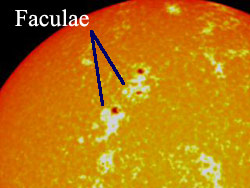 Having said all that, the sunspot cycle may have a very small effect on climate. You might think that since the spots are cooler than the solar surface we’d see a drop in light from the Sun and a corresponding cooling of the Earth during solar max. However, it’s actually the opposite! Sunspots are surrounded by a rim called faculae, and in this region the temperatures are actually higher than the average solar surface. This more than compensates for the cooler area of the spot; sunspots are about 1% dimmer than the solar surface, but faculae are 1.1 to 1.5% brighter. On top of that, faculae emit more UV than the solar surface does, and that wavelength of light is preferentially absorbed by the Earth’s atmosphere, increasing the efficiency of heating.
Having said all that, the sunspot cycle may have a very small effect on climate. You might think that since the spots are cooler than the solar surface we’d see a drop in light from the Sun and a corresponding cooling of the Earth during solar max. However, it’s actually the opposite! Sunspots are surrounded by a rim called faculae, and in this region the temperatures are actually higher than the average solar surface. This more than compensates for the cooler area of the spot; sunspots are about 1% dimmer than the solar surface, but faculae are 1.1 to 1.5% brighter. On top of that, faculae emit more UV than the solar surface does, and that wavelength of light is preferentially absorbed by the Earth’s atmosphere, increasing the efficiency of heating.
So, bizarrely, sunspots tend to warm the Earth. That jibes with the idea of a cooling trend during solar minimum; fewer spots means fewer faculae, so the Sun emits less Earth-warming radiation.
But when you look at the numbers, again, it’s not so simple. The effect from faculae is very small, not enough to significantly change the Earth’s temperature on their own.
Ah, but in the case of the Little Ice Age, there may have been more players in the game.
Jet versus the Volcano
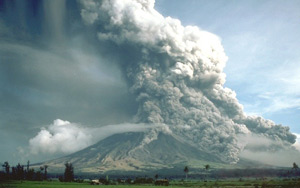 As it happens, there were some big volcanic eruptions around the time of the Little Ice Age. Ice cores trap atmospheric gases, and samples from the 1690s (a period of particularly severe cooling in Europe) show significantly more atmospheric sulfur than usual. This is a volcanic gas, and is very good at reflecting incoming sunlight. Obviously, this can have a global cooling effect.
As it happens, there were some big volcanic eruptions around the time of the Little Ice Age. Ice cores trap atmospheric gases, and samples from the 1690s (a period of particularly severe cooling in Europe) show significantly more atmospheric sulfur than usual. This is a volcanic gas, and is very good at reflecting incoming sunlight. Obviously, this can have a global cooling effect.
But there’s that word, “global”. The Little Ice Age hit Europe the hardest. Sunspots and volcanoes wouldn’t hit one region that hard without doing something to the rest of the planet. That implies a third participant… and it turns out, there is.
The jet stream is a river of air that flows roughly west to east across the Earth. It varies a lot season to season and year to year, and it can affect regional weather quite strongly. A dip south can bring very cold arctic air to one place while a northward kink keeps another region temperate. When the jet stream is strong it flows well and that doesn’t happen, but when it’s weak it can meander, flopping north and south in various locations. The jet stream strength and direction depends on many factors, including, of all things, ozone.
The dependence is complicated, but the bottom line is the jet stream is weaker when there’s less ozone (it has to do with latitude-dependent temperature gradients across the upper atmosphere; those gradients are strong in winter and weak in summer). Ozone creation depends on UV from the Sun, which is weaker during a solar minimum. See where this is going? Weaker magnetic activity on the Sun means less ozone which means a weaker jet stream which means it meanders more, bringing cold air south in some places.
And where does that happen preferentially? Give yourself a gold star if you guess Europe.
So that may be the connection between the Sun’s Maunder Minimum and the Little Ice Age. Fewer sunspots meant fewer faculae, so less heat from the Sun. Not enough to kickstart an ice age, but it had some minimal effect. Volcanic eruptions added their cooling. Finally, a weak jet stream dropped supercold air farther south into Europe – thus the winters in Europe were extraordinarily bitter, but summers weren’t all that affected, and other regions of the world were spared the worst outcomes from all this.
Mind you – and this is fairly important – there’s evidence that the Little Ice Age began long before the Maunder Minimum. It may have actually been more like series of cold pulses that started centuries earlier. So any connection between the solar cycle and ice ages is pretty weak.
Chill, dude
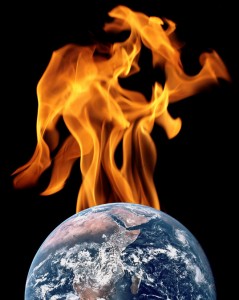 So where does that leave us? At first, it seems that a solar activity minimum leads to cooling, but as I detailed painfully above, that connection isn’t straightforward. Volcanoes played a strong role, for example, and it’s not at all clear a minimum will lead to an ice age without them. You can’t make a one-to-one connection between a lack of sunspots and an oncoming ice age.
So where does that leave us? At first, it seems that a solar activity minimum leads to cooling, but as I detailed painfully above, that connection isn’t straightforward. Volcanoes played a strong role, for example, and it’s not at all clear a minimum will lead to an ice age without them. You can’t make a one-to-one connection between a lack of sunspots and an oncoming ice age.
Moreover, it’s not clear the results from the studies indicate a weak cycle next time around. It’s possible, but not a sure thing. And a weak cycle, as Dr. Biesecker points out, doesn’t necessarily mean anything to our climate, volcanoes or not.
Also, keep in mind the Little Ice Age was not a global phenomenon, but a regional one. Even if a weak cycle occurs and it does affect us, the effects would be relatively contained. It would suck for those who got hit by it, but the Earth itself would weather through it. Haha.
And let’s not forget the elephant in the room: the amount of cooling we’d see from this even if it all came together would still be less than the global warming we’ve been experiencing since the 20th century. It might slow things down for a while, but the climate change we’re seeing now – and it’s real, folks – is more than enough to take on a little temporary cooling, especially local cooling.
So, to wrap things up in a nice little bow:
1) Claims of an imminent global ice age are at best exaggerated.
2) The link of global cooling to an extended solar magnetic minimum is tenuous, and almost certainly needs something else to force it to occur (like lots of volcanoes), and
3) We’re not even all that sure we’re headed for an extended minimum.
I know a lot of folks tend to panic, and a lot of so-called “news” outlets know that disasters sell ad space. So there you go. No need to panic yet over global cooling. And we’ve still got warming deniers to deal with.
Tip o’ the parka hood to Fark. Image credits: Flare: NASA/SDO; Snowball Earth: Neethis and Celestia; Faculae: NASA/Goddard Space Flight Center Scientific Visualization Studio; Sunspot number: NASA/MSFC; Mayon volcano: wikipedia.
Related posts:
- The Sun may be headed for a little quiet time
- Is global warming solar induced?
- New study clinches it: the Earth is warming up
- NASA talks global warming